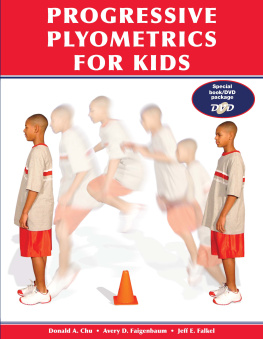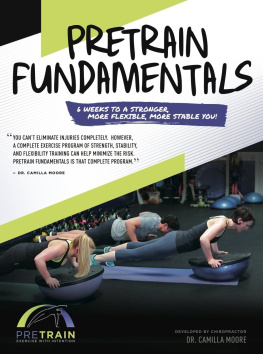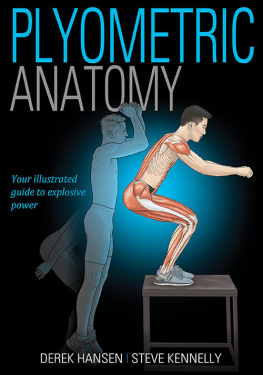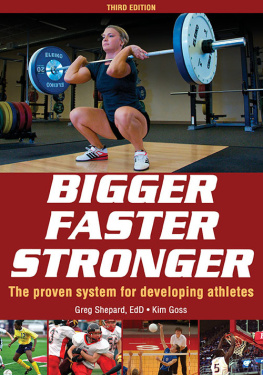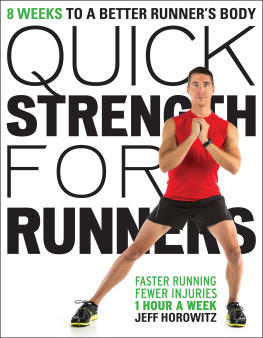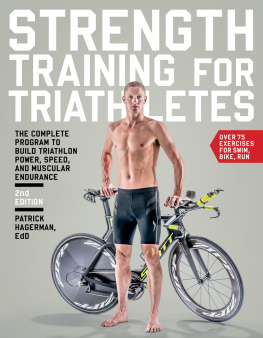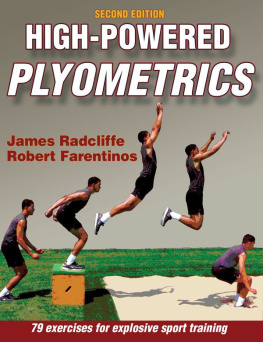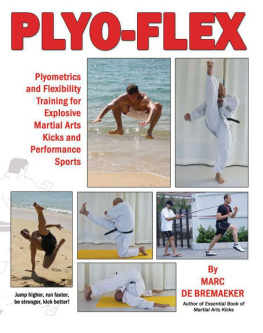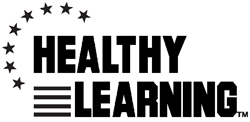Progressive
Plyometrics
for Kids
Donald A. Chu
Avery D. Faigenbaum
Jeff E. Falkel
2006 Healthy Learning. All rights reserved. Printed in the United States. No part of this book may be reproduced, stored in a retrieval system, or transmitted, in any form or by any means, electronic, mechanical, photocopying, recording, or otherwise, without the prior permission of Healthy Learning. Throughout this book, the masculine shall be deemed to include the feminine and vice versa.
ISBN: 978-1-58518-955-7
Library of Congress Control Number: 2005938380
Cover design: Jeanne Hamilton
Diagrams: Chasity Siebert and Jeanne Hamilton
Book layout: Jeanne Hamilton
Front cover photo: Brennan Tiffany and James Marsh
Healthy Learning
P.O. Box 1828
Monterey, CA 93942
www.healthylearning.com
T his book is dedicated to all the young aspiring athletes who have participated in our strength and conditioning programs over the past 30 years. Your enthusiasm to train, eagerness to learn, willingness to work hard, and commitment to athleticism continue to make us better coaches. Thanks to you, more people than ever before now understand that progressive plyometric training can be a safe, effective, and worthwhile method of conditioning for youth. We thank you for helping us develop the vision for this text, which will help teachers and coaches develop the essential knowledge and teaching skills to safely and effectively instruct children and teenagers.
F irst of all, we want to thank all the boys and girls who have participated in our programs over the years that have taught us that physical activity is a great way to have fun, make friends, and learn something new. We also want to thank the teachers, coaches, and therapists who we have worked with and who believe that a progressive plyometric training program can be safe, effective, and worthwhile for boys and girls of all abilities. We especially want to thank the stars of the book and DVD, Hunter Baird, Jenny Rivera, and Marcelis Short, for their hard work and a lot of fun. We thank Dr. Jim Peterson, Kristi Huelsing, the staff at Coaches Choice/Healthy Learning, our photographer Chris Gage, and our videographer, Mike March, for making this project a reality, as well as for all of your support, help, and encouragement along the journey. And we want to acknowledge the efforts of Mr. Jim McFarland, from Hillsborough High School in New Jersey, who helped us evaluate the efficacy of our youth conditioning programs.
S everal years ago, the authors got together to create a comprehensive, progressive program of plyometric exercises specifically designed for youth. We decided that rather than listing drills we have used successfully in the past, we would design a program that was progressive, easy to implement, cost effective, and developmentally appropriate for all children and teenagers regardless of their athletic ability. Our book is based on our firm belief that a progressive plyometric program can not only enhance athletic performance, but can also develop fundamental fitness abilities such as speed, agility, power, strength, and flexibility in youth.
Plyometrics are dynamic exercises that elite athletes have used for decades as part of their training programs. Our book is based on the scientific principles of plyometric training, but modified for boys and girls who are physically and psychologically less mature. While plyometrics were once thought of as inappropriate, if not unsafe, for use with young athletes, our clinical observations, years of coaching experience, and scientific research studies have shown that plyometric training can be a safe, effective, and worthwhile method of conditioning for children and adolescents. Since 1972, thousands of aspiring young athletes as well as elite competitors have benefited from participation in our progressive plyometric programs. While youth in our conditioning programs enhanced their physical fitness and gained confidence in their abilities to perform plyometric drills, communicating with the young participants in our programs has reinforced the importance of keeping our youth programs progressive and enjoyable.
It has been our collective experiences that have provided us with the foundation upon which to develop our progressive plyometric program. Once we observed that a well-designed plyometric training program could be safe and worthwhile for youth, we actually evaluated the efficacy of our training methods throughout the United States. Our findings challenged common misconceptions and provided reassurance that plyometric training can be part of a childs multifaceted conditioning program. For example, our research indicates that dynamic warm-up protocols are more effective for preparing youth for sport activities than a more traditional approach of static stretching. We have also observed that participation in a progressive plyometric program is essential for optimizing power performance in youth.
All youth in our after-school programs, fitness classes, and sport-training programs perform some type of plyometric training as part of their conditioning program. However, plyometrics should not be haphazardly programmed nor should youth follow adult training guidelines. The key to safe and effective youth programming is to appreciate the fact that kids are active like adults, but kids are active in different ways and for different reasons. When combined with enthusiasm and a zest for learning, our book will provide you with all the information you need to make plyometric training an enjoyable and worthwhile experience for children and adolescents. We have also included a DVD with our book that describes each of the exercises in greater detail to help athletes perform them correctly. The DVD also features coaching points for every drill to assist coaches, teachers, and parents. We hope that you will enjoy reading this book as much as we enjoyed consolidating our years of experience and research into book form.
Contents
Understanding Plyometrics
Methods and Modes
Training for Success
Program Design
Bronze, Silver, and Gold Exercises
Plyometric Training for Children and Adolescents
Selected Web and References
Understanding Plyometrics
Progressive Plyometrics Success Story | Chris was a young athlete with amazing straight-ahead speed, but had difficulty stopping and changing directions. Once he got going, few people could catch him. However, when he had to change direction or decelerate and then accelerate again, he was not nearly as fast. We started him on our progressive plyometric program, and after only a few weeks his ability to quickly change directions, stop and start, and rapidly get back up to his speed dramatically improved. |
Y ou picked up this book on plyometric training because you have at least heard about this type of exercise. You may have read about plyometric training in a fitness book or seen adult athletes performing these drills on television. The bottom line is that coaches are talking about plyometrics and athletes in nearly all sports are benefiting from this type of training. But along with this growth in popularity has come many questions. How do plyometrics work? Do they really enhance speed and power? And are plyometrics safe for children and teenagers? In this book we will dispel the misperceptions associated with plyometric training and provide you with reassurance that a progressive plyometric program can be a safe, worthwhile, and fun method of training for boys and girls of all abilities. We will help you understand the essentials of plyometric training and provide you with a simple yet effective conditioning program that can be incorporated into any childs physical activity program.
Next page
